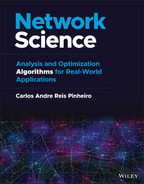About the Book
Network science is the study of connected things. Things can be represented by people, devices, companies, governments, agencies, bank accounts, etc. Connected can be represented by calls, messages, likes, money transferring, references, geo‐positioning, contracts, etc.
The study of networks has emerged in diverse disciplines as a means of analyzing complex relational data. Every industry, in every domain, has information that can be analyzed in terms of linked data. Network science can be applied to understand spatiotemporal events like virus spread or traditional business events like churn and product adoption in telecommunications and entertainment, or service consumption in retail, fraud in insurance, money laundering in banking, among many other business cases.
Network analysis includes graph theory algorithms that can augment statistical and machine learning modeling. In many practical applications, pairwise interaction between the entities of interest in the model often plays an important role. This role can be used as input or independent variable in supervised models and often they turn out to be one of the best predictors. Network analysis goes beyond traditional unsupervised modeling like clustering and supervised modeling like predictive models. Both supervised and unsupervised models are frequently used to identify hidden patterns in data. However, these models are based on the attributes describing the observations, normally entities. Network science commonly reveals hidden patterns on the relationship of these entities, rather than on their individual attributes.
Network analysis can be used to understand customers’ behavior, highlighting possible influencers within the network. Therefore avoiding churn, diffusing products and services, detecting fraud and abuse, identifying anomalies, and many other business and life science applications. It is hard to think of an application in any industry that cannot benefit from network analysis, from industries such as communications and media, banking, insurance, retail, utilities, travel, hospitality, transportation, education, healthcare, and life science, etc.
Network optimization includes graph theory algorithms that can augment more generic mathematical optimization approaches. Many practical applications of optimization depend on an underlying network. Networks also appear explicitly and implicitly in many other application contexts. Networks are often constructed from certain natural co‐occurrence types of relationships, such as relationships among researchers who coauthor articles, actors who appear in the same movie, words or topics that occur in the same document, items that appear together in a shopping basket, terrorism suspects who travel together or are seen in the same location, and so on. In these types of relationships, the strength or frequency of interaction is modeled as weights on the links of the resulting network. Particularly in network optimization, nodes can represent computers, stores, locations, cell towers, bank accounts, vehicles, trains, airplanes, or even a person walking. The occurrence of a transaction involving two nodes can represent a link between them. For example, a truck delivering goods to multiple stores with the stores representing the nodes. The truck going through these multiple stores represent a link between the stores, or the links between the nodes. The weight of these links can be defined by the frequency of the trips the truck performs between any two stores, or the number of goods delivered, or a combination of both. Analogously to the traditional network analysis approach, the network optimization methods can represent nodes and links in the same way but use them differently when distinct optimization algorithms are applied. For example, in the finance industry, bank accounts, individual persons, and organizations can represent nodes. All transactions between bank accounts, persons, and organizations can represent links. Money transfers, withdraws, payments, wires, etc., can all represent varied connections between these nodes, which may have different importance, and thus, different weights. In traditional network analysis, components, cores, or node communities can be detected, revealing groups of accounts, persons, or organizations that are strongly related. Highly weighted links can highlight connections between account, persons, and organizations that are not usual. In network optimization, the same network, based on the same graph representation (bank accounts, individual persons, and organizations as nodes, and transactions as links) can be used differently under distinct optimization algorithms. Cycles, clique, paths, and shortest paths can reveal connection patterns that cannot be highlighted by traditional network analysis. Pattern matching can search for a specific group of nodes based on particular types of links among them throughout the entire network, identifying target connections or entities. In the previous example, where stores are nodes and trucks delivering goods are links, network optimization algorithms can search for optimal routes to minimize the time or the distance when trucks are delivering the goods. By adding a depot as a node and a vehicle capacity for the truck, network optimization algorithms can also search for the optimal trips that trucks need to perform when delivering the goods from the depot throughout all the stores.
